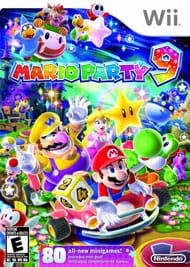More Game, Less Party
Few party game franchises have lasted as long as the Mario Party series. Many gamers have fond memories of long nights filled with games that dragged on and on because that one friend of yours always insisted on practicing before every minigame. Because some games of Mario Party could easily last for an hour or two, it has always been the sort of game that you play a lot right after it releases, only to be left on the shelf collecting dust afterward. The large time investment turns people of, when more manageable party activities, such as Rock Band, fighting games, or even split-screen shooters are available. Fortunately, Nintendo knows this and has developed the newest Mario Party title, Mario Party 9, to fix the flaws that hold back the franchise’s replay value.
Co-op is the new name of the Mario Party game. Instead of traversing the game’s many boards on foot, all four players hop in a vehicle and drive around the board together. Instead of paying coins to get stars, characters collect “mini-stars” by passing them on the board and completing certain tasks and events. Similarly, players can lose mini-stars by landing on a bad space or triggering a negative board event. At the end of the game, these mini-stars determine who wins and you actually get more mini-stars by working together.

As you drive around the board, certain board events will affect different players depending on where they are sitting in your vehicle. The player in the driver’s seat will always reap the rewards (or penalties) of most of the spaces on the board. However, mystery green spaces and board events can affect people in any of the other seats as well. The game’s trailer shows a spot where driving past a piranha plant reduces the star total of the player in the seat to the left. So you can still screw over your friends, albeit indirectly.
Several different board spaces have been confirmed so far, and many of them have changed in functionality. There are no more coins in Mario Party 9, just mini-stars, and so blue and red spaces have to do something different. Blue spaces are now called “dice spaces,” and anyone who lands on them will either receive a special dice block, three mini-stars, or trigger a free-for-all minigame. Green happening spaces and random spaces trigger board events that can be good or bad, while blank green spaces do nothing at all.

There are now minigame spaces for every minigame type. Competition minigames cause everyone to wager their stars, 1-vs.-Rival games pit the active player against the rest of the party, and vs. spaces trigger plain old four-player free-for-all games. There are also Bowser Jr. spaces that put you against Bowser Jr. in a random minigame. Unlike the Bowser space, which always causes a negative outcome, you actually have a chance to win against Bowser Jr.
Other spaces include the Lucky space, which allows you to get out of the car and follow your own secret route, the Reverse Space, which makes the car roll backward; the dash space, which lets you roll again; and the shuffle space, which switches turn order around. There are also spaces that simply give or take away mini-stars, and DK spaces, which give you an opportunity to increase your star total by great amounts. Aside from that, most of the other spaces are board specific.
The boards have also changed. Instead of a forever looping circle, as you may be used to in past Mario Party games, these boards have a beginning and an end. When you reach the end, the game is over, which thankfully solves the whole “this game is lasting forever” problem. Minigames no longer happen after every four turns. Instead, they only occur when you land on a minigame space. This makes the general flow of the game feel much more constant and quick. It also means that you can strategically avoid minigame spaces if you want to keep a hold of your mini-star lead or want the game to end more quickly.

Boards will also have “bosses” to fight as well. When you encounter a boss, all players will have to work together to take him down. Mini-stars are awarded at the end of each boss fight. Perform well and you’ll get more stars. Perform poorly and you’ll get fewer. However, one lagging character can ruin a boss fight for the whole party, so it behooves you to work together in such a way that you all succeed. Just make sure that you succeed the most. There will be two bosses per stage: one mid-boss and one final boss that ends the game. However, the Bowser Jr. minigames are essentially boss fights as well.
All these changes make for a quicker, more streamlined, more active Mario Party experience. Everyone is essentially playing at the same time, working together to eventually get to the end of a board and defeat a boss. Mini-stars flow back and forth easily, but not nearly enough to cause random game-changing swings. No longer will the game come down to one star for each player, with only the bonus stars determining the winner. Believe it or not, Mario Party has become less of a random dice fest; now it actually takes strategy.
All that’s left to be seen is whether gamers will enjoy this new, more strategic Mario Party. Mario Party 9 does away with many Mario Party traditions. In fact, it feels like a whole new game. Purists might be offended, but anyone looking for an enjoyable play experience will probably look at Mario Party 9 as a step in the right direction.
Game Features:
